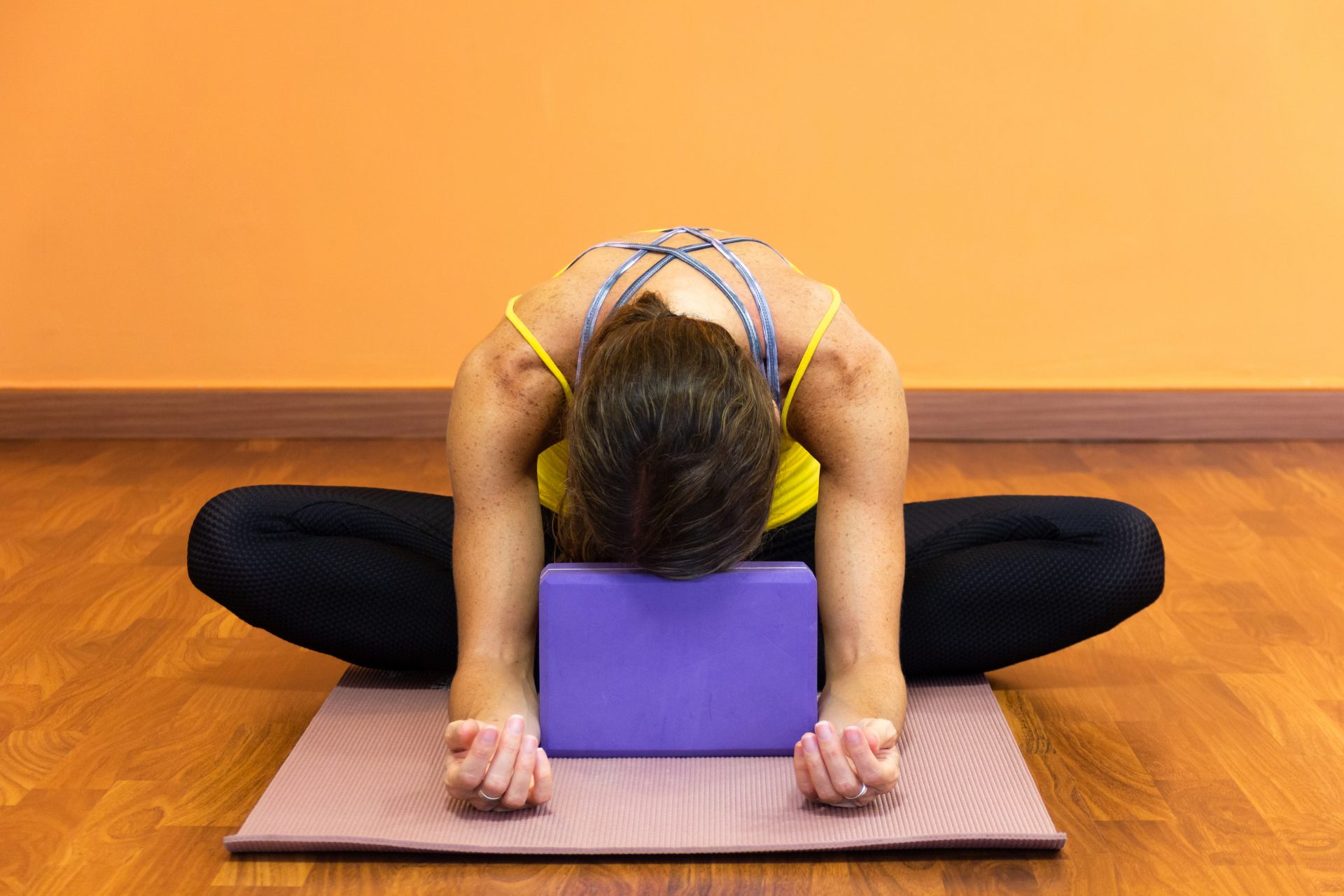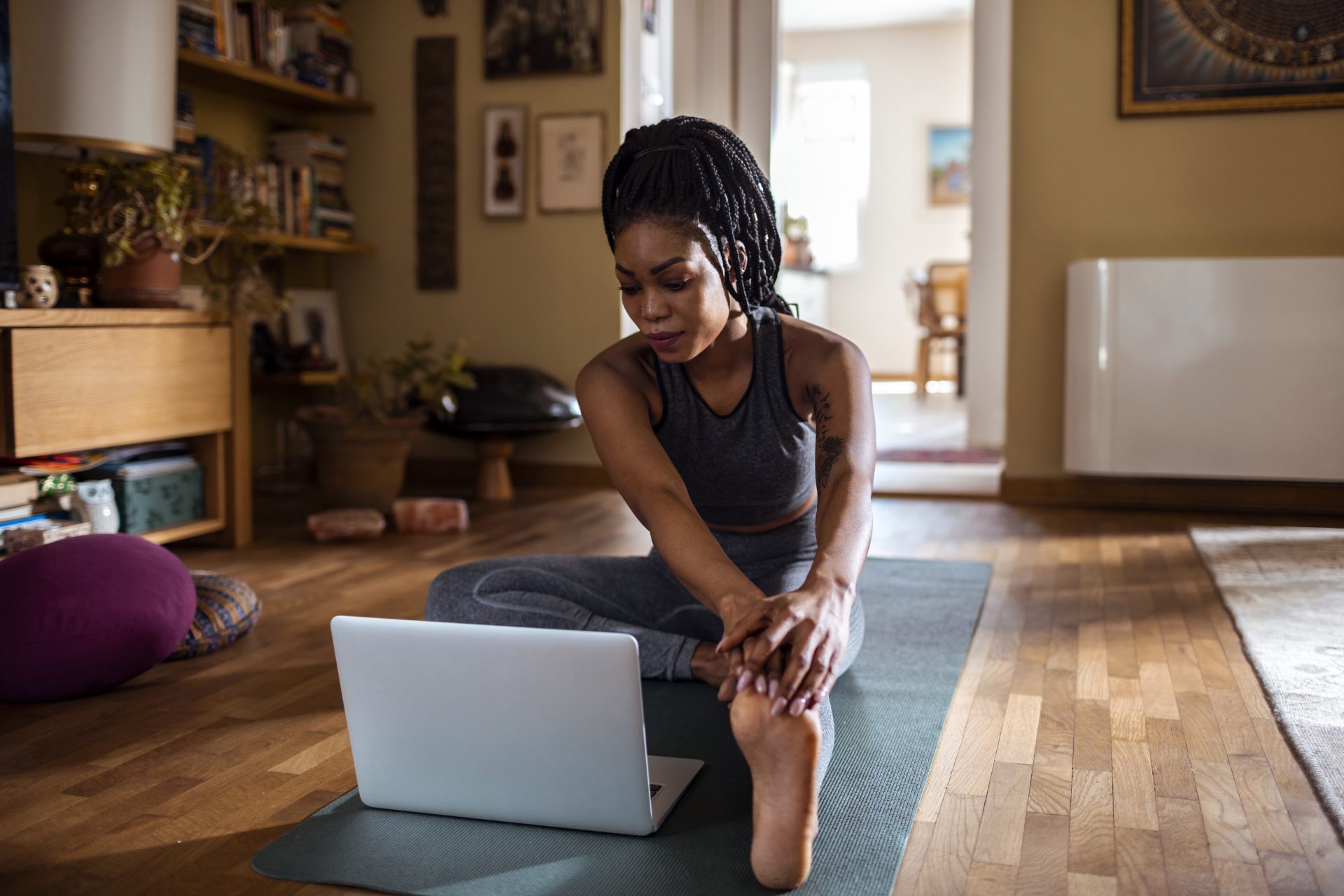How yin yoga eased my pandemic anxiety

For years, I thought that yoga was about strength-based, quick flows. It was only when the world shut down that I realised how much more there was to get out of slowing down.
This past year has been an anxiety-riddled one for many of us. I’m no different; since getting stuck overseas from March 2020, dealing with a breakup, coming off antidepressants and the continuous uncertainty of the pandemic, I’ve been in a constant state of anxiety. I used to think running or intense HIIT was the best outlet for my stress but one morning, when I was too tired to even do my usual half-hour YouTube vinyasa, I tried a morning yin yoga class. And I was hooked.
Yin yoga is much slower-paced than other more dynamic, heat-building (yang) styles of yoga (like vinyasa) and is predominantly floor-based. Poses are typically held for anything between three to 10 (!) minutes.
I’ve always thought that yin wasn’t for me, assuming it was boring, too slow, and not enough of a workout. Turns out it’s a perfect workout – for the mind. I thought my head would be all over the place with such lack of movement, but the long holds and conscious breathing meant my brain soon began to switch off and my anxiety lessened. I couldn’t believe it.
I don’t do yin every day but it’s my go-to when I’m feeling super anxious, and I love lighting loads of candles, rolling out my mat and doing it before bed (it really helps your mind and body prepare for slumber town).
You may also like
Feeling stressed and anxious before bed? These yoga poses will help you to get to sleep
HOW CAN YIN HELP DECREASE ANXIETY?
Yin encourages a deep, slow and even breath, which in itself helps quieten the chatter in the mind. However, it’s also the long holds that can have a positive impact on your mood.
“Yin stimulates a feeling of safety in the nervous system,” explains Tye Fielding, E-500RYT and yoga manager at Talalla Retreat.
“Stress is one of the things most humans have in common, and when stress is repeated on a regular basis, the body stores it as trauma. Through deep fascial (connective tissue) and muscular release, the body is able to physically release this stored tension which leads to the feeling of relaxation, particularly when yin yoga is practiced regularly.”

WHY ARE YIN POSES HELD FOR SO LONG?
As mentioned, poses tend to be held for anywhere between three and 10 minutes – which can be incredibly challenging. Other forms of yoga promote a “flow” between different positions, meaning that you only hold them for up to a couple of minutes at a time. So why hold poses for so long?
“The reason we hold the poses for this long is because it takes around two minutes for our muscles to completely relax,” explains Kelly McGrath, life coach and yin yoga teacher.
“This then allows us to get into the deeper connective tissue and fascia in our body, which helps with mobility and flexibility. So if someone really wants to touch their toes, then yin is the one! Yin helps to increase our range of motion and is also a great complementary practice if you are very active (so have a more ‘yang’ lifestyle) or do a lot of running, as our yin poses can help tighter areas such as the hamstrings, hip flexors and quads slowly release.”
From a mental health perspective, holding the poses helps to activate the body’s parasympathetic nervous system, which is the opposite of the “fight or flight” response that anxiety creates. That helps to decreases heart and respiratory rates, while increasing digestion. While exercise in general is associated with lowering stress levels, yin is unique in the way it slows down our systems. A 2019 study got a group of people to do an hour of yin yoga one week and an hour of aerobic exercise the other. Immediately before and after the sessions, they completed an anxiety and mindfulness inventory. While no differences were reported regarding mental health before or after the aerobic session, participants reported as having a “significant reduction in state anxiety and trait anxiety after the yin yoga,” leading the study to conclude that “yin yoga should be considered as a potential treatment option for anxiety.”
You may also like
4 unhelpful thoughts that could be causing your anxiety – and how to fix them
IS YIN UNCOMFORTABLE
While yin is often uncomfortable, it should never be painful and poses shouldn’t be forced – it’s supposed to be a gentle practice.
“The poses themselves are primarily passive and we generally want to be at about a six out of 10 for effort – so that sense of ‘surfing the edge’ of sensation,” says Kelly. “Yin is all about introspection, you’re focusing on the target areas of the body and not how the pose looks, as each pose will look very different from person to person.”
The best bit about yin is that you can wear your comfiest clothes – even your pyjamas and fluffy socks! Your body temperature can decrease during the practice due to your stillness, so it’s best to wear warm layers.
CAN YIN BE PRACTICED SAFELY AT HOME?
The joy of practicing yin at home rather than a studio is that you can roll straight into your bed afterwards – though you should be mindful when practicing without a teacher.
“As with any physical practice, it is important to be mindful of any injuries, illnesses, underlying conditions or pregnancy and consult your GP before starting if concerned,” says Kelly. “What I tell my online students is to always listen to their bodies as they know best – if something doesn’t feel right or you know a pose won’t work due to an underlying condition, you can take a different pose (such as a child’s pose), or modify.”
Props are often used in studio classes but if you don’t have these at home, don’t worry. Kelly recommends using two to three pillows in place of a bolster, utilising cookbooks instead of blocks and having a bathrobe tie to hand to use as a strap. Easy.

WHEN SHOULD YIN BE PRACTICED?
I practice yin at any time of day when I’m feeling super stressed, when my body feels tight post-run, or after sitting at a desk all day. While “yin is commonly practiced in the evening to assist with winding down and preparing for a good night’s sleep,” Tye points out, yin can be done at any time of the day that suits you.
“If you are someone who’s anxious or has a stressful job, practicing yin in the mornings or midday may help lower your stress levels and increase your ability to stay calm under stress. If you have a tendency to be sleepy or lazy, I would suggest saving your yin practice until the evening. Observe your energy throughout the day – when do you feel most anxious, stressed or physically tight? Try doing it then.”
So, instead of doomscrolling before bed tonight, why not give yin a go? There are plenty of classes on YouTube, or you can try the below postures, holding them for three minutes initially and then building up.
5 anxiety-soothing yin poses
Tye recommends trying the following poses to reduce feelings of stress and anxiety. They’re all floor-based and mainly supportive so get into something warm and comfy, grab your bolster (or pillows) and block (or little pile of books), and hop onto your mat. I like to have a few candles going to create a really soothing, relaxing atmosphere. Try to stay in each pose for at least three minutes.
1. Supported supine butterfly
- Place the bolster lengthways behind you, sit in butterfly posture with your knees apart and soles of feet together. Place a block under each outer thigh if you need support in your hips.
- Lie on the bolster and spread the arms out wide with the back of your hands on the floor.
- Focus on your diaphragmatic breathing, with slow long breaths in and out. Try to exhale two counts, linger, then inhale to help the body relax.
2. Supported dragonfly pose
- Sit with legs apart in straddle.
- Take one, two or three bolsters in front of your crotch, lift high in the torso and fold yourself over the props.
- Turn your head to one side, then turn the other halfway through the hold, or place forehead on the bolster.
- Focus on your breath, in particular the exhalation.
3. Child pose C
- Come to hands and knees, separate the knees wide and toes together (if your knees are sensitive, place a folded blanket underneath them).
- Sink the hips back to your heels (if this feels challenging or you need more support try placing a bolster or rolled blanket between your calf muscles and hamstrings).
- Rest your forehead on the earth.
- Place your arms beside you.
4. Supported deer pose (repeat both sides)
- Bend your right knee into half-butterfly with the heel about a foot away from the pelvis, then place your left knee into the arch of the right foot. Bend the left knee until the foot is closer to ninety degrees from the knee towards the bottom. (The legs will look a bit like a pinwheel).
- Place the bolster lengthways, with the base of the bolster next to the right hip/upper thigh.
- Rotate the torso in the direction of the right knee and walk the torso forward until it rests on a bolster. The arms can relax out to the side like goalposts. Turn your head to the side.
5. Supported corpse pose
- Fold a blanket flat and square.
- Sit in staff pose (legs out straight, sitting up with back straight – like you’re the letter “L”) place a bolster under the backs of your knees – a hand distance from your tail bone.
- Lie down – the blanket should start at the bottom of your ribs.
- Place one hand on your belly. Inhale, feeling the stomach rise only to the start of the blanket and then exhale. Repeat stomach breath for five rounds and then invite the full diaphragmatic breath, noticing the back of your ribs and lungs also expand.
Follow on @StrongWomenUK Instagram for the latest workouts, delicious recipes and motivation from your favourite fitness experts.
Images: Getty
Source: Read Full Article